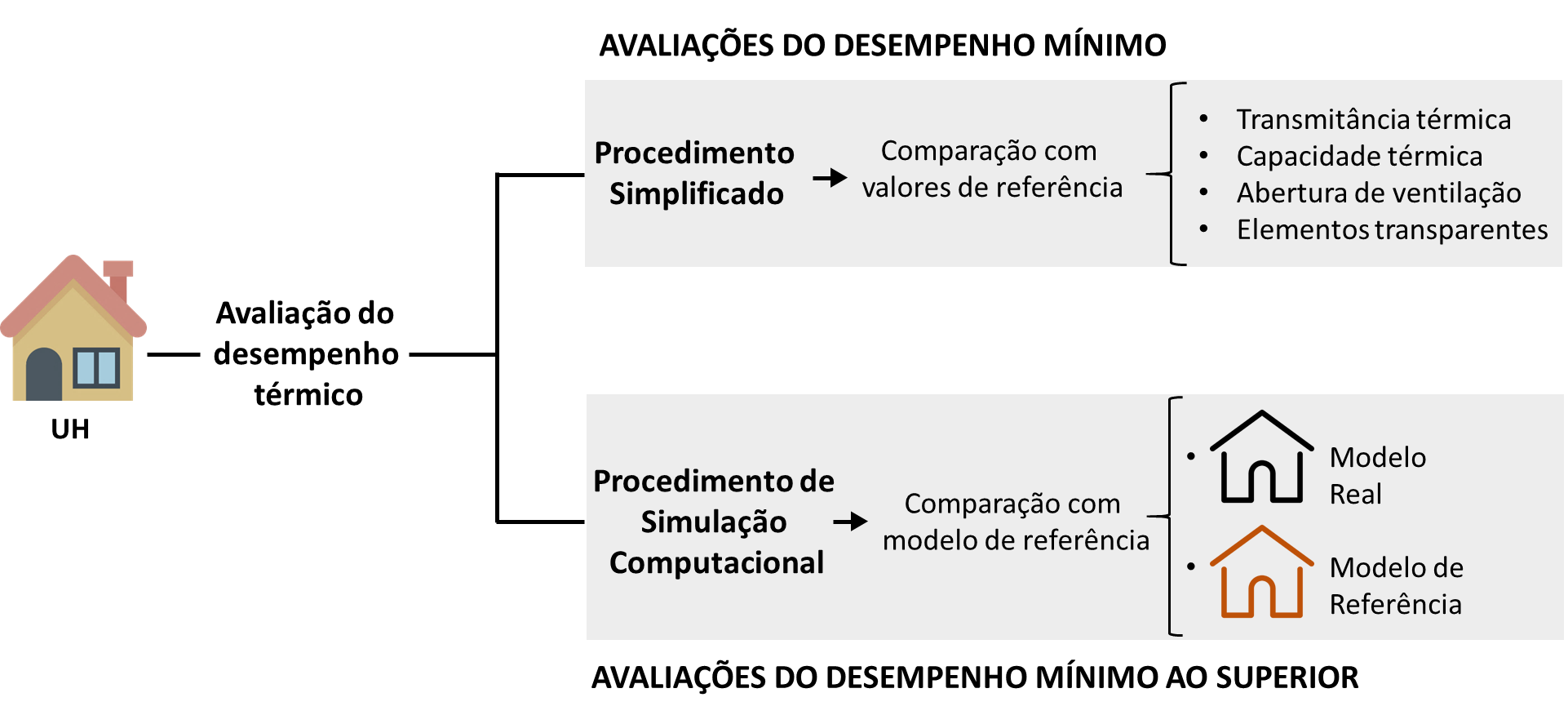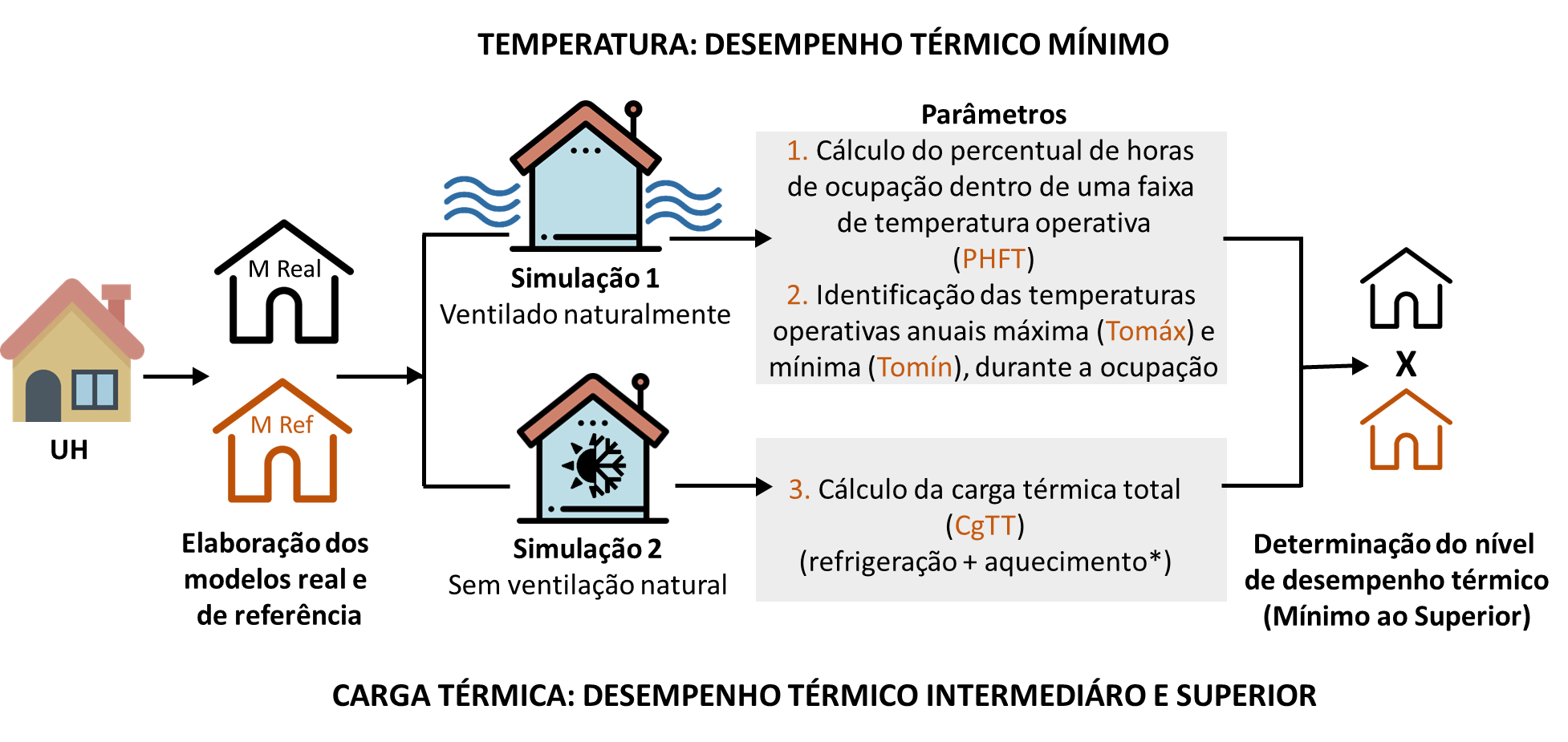A norma brasileira de desempenho de edificações residenciais, ABNT NBR 15575 (ABNT, 2013), entrou em vigor em 2013, com o objetivo de estabelecer os requisitos dos usuários para os ambientes habitacionais. O desempenho é considerado pela norma como o “comportamento em uso de uma edificação e de seus sistemas”. Dessa forma, dentre os requisitos de habitabilidade, é estabelecido o desempenho térmico, que visa garantir ao usuário condições térmicas adequadas para o desenvolvimento das suas atividades na habitação.
Considerando as limitações identificadas no método de 2013 (SORGATO et al, 2012), em 2018 o LabEEE iniciou a elaboração de uma proposta para a revisão da análise de desempenho térmico da NBR 15575. Após um período de desenvolvimento e consolidação do novo método, em 2020 o texto proposto para a revisão foi enviado para a Comissão de Estudos da ABNT e, após discussões, a emenda de norma entrou em consulta nacional entre 17 de novembro e 16 de dezembro de 2020. A publicação está prevista para início de 2021.
Segundo o método proposto, a avaliação do desempenho térmico pode ser realizada por meio de dois procedimentos, simplificado (Parte 4 – Requisitos para os sistemas de vedações internas e externas - SVVIE e Parte 5 – Requisitos para os sistemas de coberturas) ou de simulação computacional (Parte 1 – Requisitos Gerais), conforme ilustra a figura abaixo.

O procedimento simplificado avalia o desempenho térmico mínimo da unidade habitacional (UH). No novo texto, a principal inovação neste procedimento foi a implementação do critério “Elementos transparentes” na Parte 4 da normativa. Este critério limita a área de superfície de elementos transparentes nos ambientes de permanência prolongada (APP), salas e dormitórios, em proporção à área de piso. A proporção permitida para os elementos transparentes considera também a existência de sombreamento horizontal, o fator solar do vidro ou a etiqueta da esquadria (conforme ABNT NBR 10821). No texto normativo de 2013 não havia limitante para a área de vidro nos APP, permitindo a construção de UH totalmente envidraçadas.
Outro ponto de inovação da emenda é a recomendação de que seja considerada a degradação da absortância à radiação solar, indicando procedimentos de medição ou valores obtidos em estudos de campo. No texto normativo proposto, a consideração da degradação tem caráter informativo, o que já é considerado um avanço, visto que anteriormente não se mencionava a possibilidade de as propriedades térmicas das superfícies sofrerem alterações ao longo do tempo.
O procedimento de simulação computacional representa a maneira mais abrangente e representativa de análise do desempenho térmico disponível no método proposto para a NBR 15575, permitindo avaliações para a obtenção de todos os níveis de desempenho (mínimo, intermediário e superior). Algumas das principais atualizações propostas para o procedimento de simulação computacional são:
- Adoção de simulações anuais, ao contrário da consideração de dias típicos de verão e inverno;
- Consideração da edificação na fase de uso e operação, visto que são modeladas as cargas térmicas internas (pessoas, iluminação e equipamentos);
- Avaliação da edificação em duas condições de uso: com ventilação natural e sem ventilação natural. São consideradas estratégias de ventilação natural, associadas com a quantificação da carga térmica a ser removida quando a ventilação for insuficiente para a obtenção de condições térmicas adequadas nos ambientes;
- Modelagem de janelas operáveis, com trocas de ar obtidas a partir da velocidade e direção do vento fornecidas pelo arquivo climático, ao invés de uma taxa de renovação de ar fixa sem abertura das janelas;
- Consideração do cálculo da carga térmica, de forma a avaliar o desempenho térmico da edificação frente ao uso de sistemas de ar condicionado, visto que esses equipamentos estão cada vez mais presentes nas residências brasileiras (EPE, 2020);
- Análise considerando a comparação entre um modelo do edifício projetado e um modelo de referência (mesmo edifício com características de referência);
- Estabelecimento de novos indicadores para a avaliação do desempenho térmico: Percentual de horas de ocupação dentro de uma faixa de temperatura operativa (PHFT); temperatura operativa anual máxima e mínima da UH (Tomáx e Tomín); e carga térmica total (CgTT).
Na figura abaixo são ilustrados quais indicadores de desempenho térmico e modelos de simulação são necessárias para a avaliação dos níveis mínimo, intermediário e superior.

Abaixo disponibilizamos alguns documentos que podem servir de apoio à aplicação e ao entendimento da emenda proposta para os capítulos de desempenho térmico da NBR 15575. Recentemente, a NBR 15220-3 foi revisada a partir da publicação de um novo zoneamento brasileiro. Abaixo foram disponibilizados, junto com as emendas das Partes 1, 4 e 5 da NBR 15575 e a Base Padrão de Arquivos Climáticos para execução das simulações computacionais, os resultados de uma análise de equivalência entre os zoneamentos na forma de proposta de emenda das 3 partes publicadas. Estas emendas apenas corrigem o zoneamento para a nova NBR 15220-3:2024, não revisando nenhum dos requisitos de desempenho térmico. Estes drafts foram enviados ao CB002 em 28 de março de 2025.
Dentre os demais documentos incluídos abaixo estão as emendas das Partes 1, 4 e 5 da NBR 15575 e a Base Padrão de Arquivos Climáticos para execução das simulações computacionais.
- Emenda: NBR 15571-1 (draft ajuste novo zoneamento climático)
- Emenda: NBR 15571-4 (draft ajuste novo zoneamento climático)
- Emenda: NBR 15571-5 (draft ajuste novo zoneamento climático)
- Emenda: NBR 15575-1
- Emenda: NBR 15575-4
- Emenda: NBR 15575-5
- Base padrão de arquivos climáticos
- Arquivo de simulação exemplo (residência unifamiliar – modelo de referência)
- Planilha de cálculo dos indicadores
- Artigo publicado no XVIII ENTAC 2020: “Proposta de Método de Avaliação do Desempenho Térmico de Residências: NBR 15575”
- Artigo publicado no XVIII ENTAC 2020: “Proposta para as Escalas dos Níveis de Desempenho Térmico de Residências: NBR 15575”
- Manual de simulação computacional de edifícios com o uso do objeto Ground Domain no programa EnergyPlus – Versão 9.0.1
- Manual de simulação computacional de edifícios naturalmente ventilados no programa EnergyPlus – Versão 9.0.1
- Videoaulas da capacitação na seção de desempenho térmico da NBR 15575-1:2021, procedimento de simulação computacional
- Modelos de referência de Habitações de Interesse Social
- Atualização dos arquivos climáticos nas normas e regulamentos relativos à Eficiência Energética de Edificações
SORGATO, M.J.; MARINOSKI, D.L; MELO, A.P.; LAMBERTS, R. Nota técnica referente à avaliação para a norma de desempenho NBR 15575 em consulta pública. 2012.
ABNT ASSOCIAÇÃO BRASILEIRA DE NORMAS TÉCNICAS. NBR 15575: Edificações habitacionais - Desempenho. Rio de Janeiro, 2013.
ABNT ASSOCIAÇÃO BRASILEIRA DE NORMAS TÉCNICAS. NBR 10821: Esquadrias para edificações, Parte 4: Esquadrias externas – Requisitos adicionais de desempenho. Rio de Janeiro, 2017.
EPE. EMPRESA DE PESQUISA ENERGÉTICA. NOTA TÉCNICA: AÇÕES PARA PROMOÇÃO DA EFICIÊNCIA ENERGÉTICA NAS EDIFICAÇÕES BRASILEIRAS: NO CAMINHO DA TRANSIÇÃO ENERGÉTICA. Brasília, 2020. Disponível em: <https://www.epe.gov.br/sites-pt/publicacoes-dados-abertos/publicacoes/D…;. Acesso em: 04 dez. 2020.
- Roberto Lamberts - Currículo Lattes
- Ana Paula Melo - Currículo Lattes
- Deivis Luis Marinoski - Currículo Lattes
- Amanda Fraga Krelling - Currículo Lattes
- Cristiano André Teixeira - Currículo Lattes
- Letícia Gabriela Eli - Currículo Lattes
- Lorrany da Silva Mendes - Currículo Lattes
- Marcelo Salles Olinger - Currículo Lattes
- Rayner Maurício e Silva Machado - Currículo Lattes
- Rodolfo Veiga - Currículo Lattes
- Tiago de Castro Quevedo - Currículo Lattes